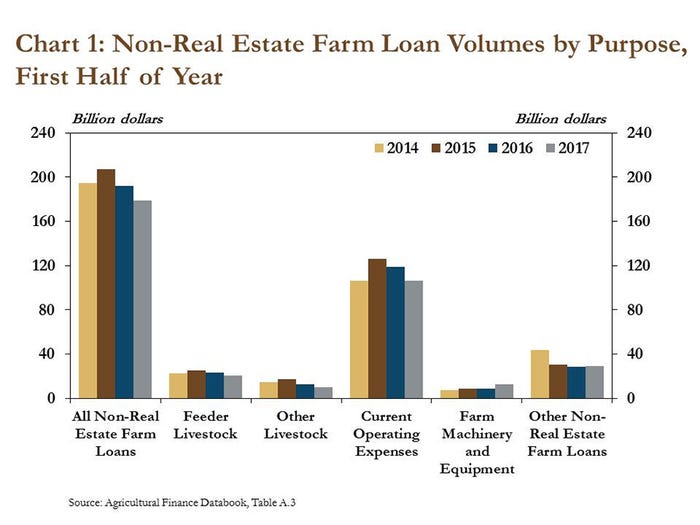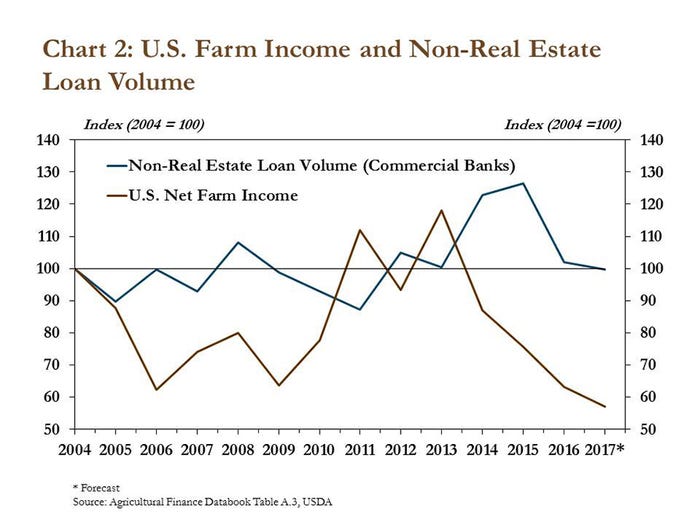Conditions have resulted in rising farm loan interest rates.

Agricultural lending at commercial banks was steady in the second quarter, but risks in the farm sector continued to weigh on loan growth and credit conditions, according to the latest "Ag Finance Databook" by the Federal Reserve Bank of Kansas City, Mo.
Authors Nathan Kauffman, assistant vice president and Omaha, Neb., branch executive, and Matt Davis, assistant economist, wrote that the volume of non-real estate farm loans increased only slightly from a year ago as interest rates continued to climb and maturity periods lengthen.
“While the rate of farm loan delinquencies edged higher, the performance of agricultural banks generally remained strong, even as farmland values in most areas continued to decline,” they said.
The pace of farm lending at commercial banks remained relatively steady in the second quarter of 2017. The survey of "Terms of Bank Lending to Farmers" showed that the volume of non-real estate farm loans originated in the second quarter increased less than 4%. Farm loan volumes at commercial banks with a sizable farm loan portfolio rose about 7% from the previous year, accounting for the slight overall increase. The volume of new farm loans in banks with a smaller farm loan portfolio, however, continued a recent trend of decline from a year ago.
Despite the slight uptick in the second quarter, Kauffman and Davis noted that the total volume of new farm loans in the first half of 2017 remained subdued.
The total volume of farm loans originated in that time was 7% less than in the first half of 2016 (Chart 1).

“Although farm lending at commercial banks appears to have slowed over the past year, some of the sluggishness in the first half of 2017 may have been due to a prolonged renewal season,” the report noted. “Amid a recent decline in working capital and a slight increase in risk associated with agricultural lending, some bankers and borrowers have taken more time to reaffirm financials, expenditures and loan terms from one year to the next.”
Persistent declines in farm income have likely slowed the volume of new non-real estate loans as bankers and borrowers have sought to manage risk, the authors explained.
The U.S. Department of Agriculture’s most recent forecast showed that net farm income in 2017 is expected to be about 10% less than a year ago and more than 50% below the recent peak in 2013 (Chart 2).

“After rising until 2015, non-real estate farm lending has slowed alongside the declines in farm income,” the Fed report said.
Risk in the sector has also resulted in rising interest rates on farm loans, Kauffman and Davis said. Specifically, interest rates on loans for operating expenses, farm machinery and other livestock have increased about 25-50 basis points year over year.
Furthermore, the report showed that fewer loans were made during the second quarter of 2017 at an interest rate of less than 4%. To compare, nearly 40% of loans in 2015 carried an interest rate below 4%, and only 9% carried an interest rate above 6%. In 2017, however, only 22% of loans carried an interest rate below 4%, and 14% carried an interest rate above 6%.
Bankers have also lengthened maturity periods as an additional risk management strategy, according to the report. For example, the average maturity for non-real estate farm loans has increased sharply since 2015. After averaging about 23 months from 2007 to 2014, maturities as of the second quarter of 2017 have jumped to 35 months.
“Bankers likely have increased maturities to improve cash flow and financial flexibility in the near term,” the authors explained.
Farm debt outstanding at commercial banks remained stable in the first quarter, and data aggregated from Call Reports indicated that total farm debt increased only 2% from a year ago.
The report noted that gains in farm real estate debt continued to drive the increase as non-real estate debt declined for a second consecutive quarter.
Consistent with the past two quarters, real estate lending over the last 20 years has been stronger and more stable, particularly during downturns in the farm economy, the authors explained.
Farm income declined nearly 30% from 2001 to 2002 and decreased 21% from 2008 to 2009 alongside a drop in commodity prices. In both time periods, and the years immediately following, however, Kauffman and Davis pointed out that farm real estate lending continued to rise, while non-real estate lending declined.
“As in the past, borrowers appear to be responding to reduced farm income by making significant cuts to production expenses and restructuring some non-real estate debt onto longer-term real estate loans,” they said.
The tough agricultural economy has resulted in a slight increase in farm loan delinquency rates, but the report showed that they still remain historically low. Delinquency rates for both farm real estate and non-real estate farm loans only slightly exceeded 2%.
“Total delinquencies for farm real estate and non-real estate loans had not been above 2% since 2013 and 2012, respectively, but both have trended higher in recent quarters. However, delinquency rates have remained near their 10-year averages and less than the average rate for all bank loans,” the report added.
Despite the rising trend in farm loan delinquency rates, the authors said the performance of agricultural banks has remained steady. Notably, the rate of return on assets has remained slightly above the five-year average of 1.1%. Likewise, the rate of return on assets at agricultural banks has remained above the rate of return at other small banks.
Regional Federal Reserve surveys also indicate that borrowers’ demand for financing has generally remained strong. Demand for farm loan renewals and extensions remained elevated in each Federal Reserve district, marking the ninth consecutive quarter that each district has reported an increase. Each district has also reported a decline in the rate of loan repayments for a ninth consecutive quarter.
As such, weaker repayment rates and strong loan demand has slowed the growth of funds available for agricultural loans. The report pointed out that funds available for financing in 2012 and 2013 grew sharply in most districts, but by the first quarter of 2017, available funds declined in the Kansas City district from the previous year and were flat in the Minneapolis, Minn., and St. Louis, Mo., districts. Credit availability increased modestly in the Chicago, Ill., and Dallas, Texas, districts, but at a slower pace than previous years.
Farmland values continued to decline amid slightly weaker credit conditions and a sluggish farm economy. Specifically, bankers in states with a heavy reliance on income from wheat and cattle, such as the Mountain states, South Dakota and Kansas, reported relatively large declines in farmland values from the previous year. Bankers in Texas, southern Wisconsin and Iowa, on the other hand, reported slight increases, which Kauffman and Davis said is likely due to strong demand for farmland and limited sales.
“Farmland values in most other states remained flat from the previous year,” they added.
All things considered, the authors concluded, “If farm income remains low, agricultural lenders may need to adjust to an environment of persistently sluggish loan growth and heightened risk in their farm loan portfolio.”
About the Author(s)
You May Also Like

.png?width=300&auto=webp&quality=80&disable=upscale)

